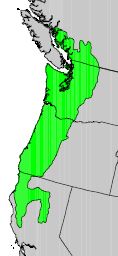….in the same part of the country there is also another growth which resembles the white maple in its appearance, only that it is by no means so large; seldom being more than from 6 to 9 inches in diameter, and from 15 to 20 feet high; they frequently grow in clusters as if from the same bed of roots spreading and leaning outwards…Merriweather Lewis, February 10, 1806, ear the Klickitat River, WA
Vine maple is a native shrub/tree to western North America that ranges from southern British Columbia to northern California. It usually grow 15 – 25 ft. tall but occasionally grows higher and up to 59 ft. tall. It has a crooked trunk with twisted spreading limbs and a low irregularly shaped crowns. It grows in the understory of forests and typically gets quite spindly – extending its branches around in search of light. Woe to the forest biologist or bushwhacking backpacker as these spreading branches seem to tangle you up and grab your ankles – thus its common name.

It has broad serrated leaves with 7-9 shallow notched lobes, white flowers, and a winged fruit (samaras) that form a straight line, unlike some other maples with a v-shaped fruit.

t occurs most frequently on moist soils that are rich in nitrogen, along stream banks or the fringe of wetlands. Typical associated plants include bigleaf maple, Douglas fir, western hemlock, grand fir, and sword fern. It has a wetland designation of Facultative – which means it tolerates saturated soils quite well.
Vine maple was used by Coastal Salish people for a variety of items including bows, frames for fishing nets; tea made from the roots, and burnt bark to combat dysentery. The sap contains some amount of sugar and was used as a drink or concentrated into syrup by boiling. Acer – Latin for sharp, referring to the ends of the leaves and circinatum – circular, for the outline of the leaf.
Vine maples, as all maples, have opposite branching – sub-branches emerge from the main branch in pairs opposite one another. This branching pattern is less common than alternate branching and can those trees or shrubs can be remembered by the abbreviation MAD-Cap-Horse – which stands for Maple, Ash, Dogwood; the Caprifoliaceae family (Viburnums, honeysuckle, and such); and the horse chestnut group (Aesculus genus) that include buckeye trees. The leaves follow the same pattern, emerging from opposite sides of a branch.
The seeds and buds of the plant provide food for squirrels, chipmunks, and numerous birds and during the spring and summer the leaves and twigs are a preferred food for black-tailed deer and elk. Lewis and Clark came across the plant and both made journal entries about it.

This is a common plant for restoration plantings because it is known to root easily and is pretty hardy. A couple of long-term restoration sites we have been monitoring have had some impressive growth of vine maples with 4 inch diameter trunks after just a few years. This shrub/tree also is popular as an ornamental planting for the same reason – plus they put on a nice autumn color show. When planted ornamentally it will often form an aesthetically pleasing layered branching pattern as it searches for the most light available. It is an enthusiastic grower so you’ll need to keep it in check.
